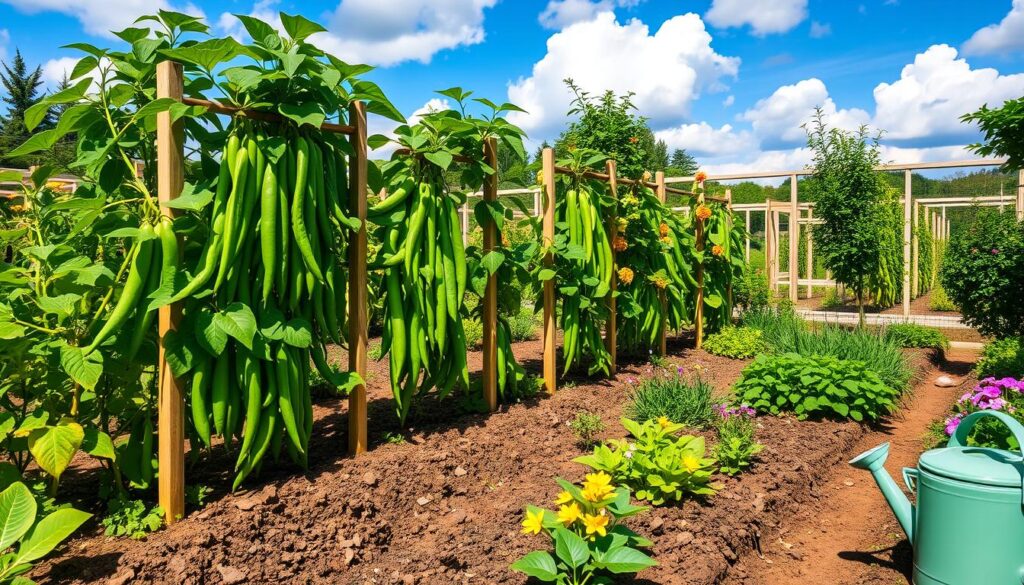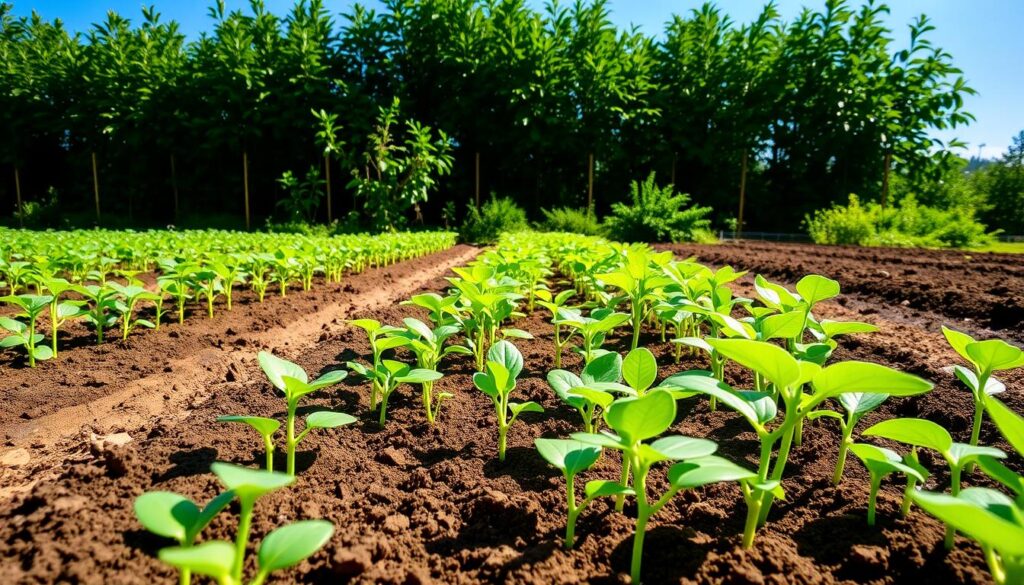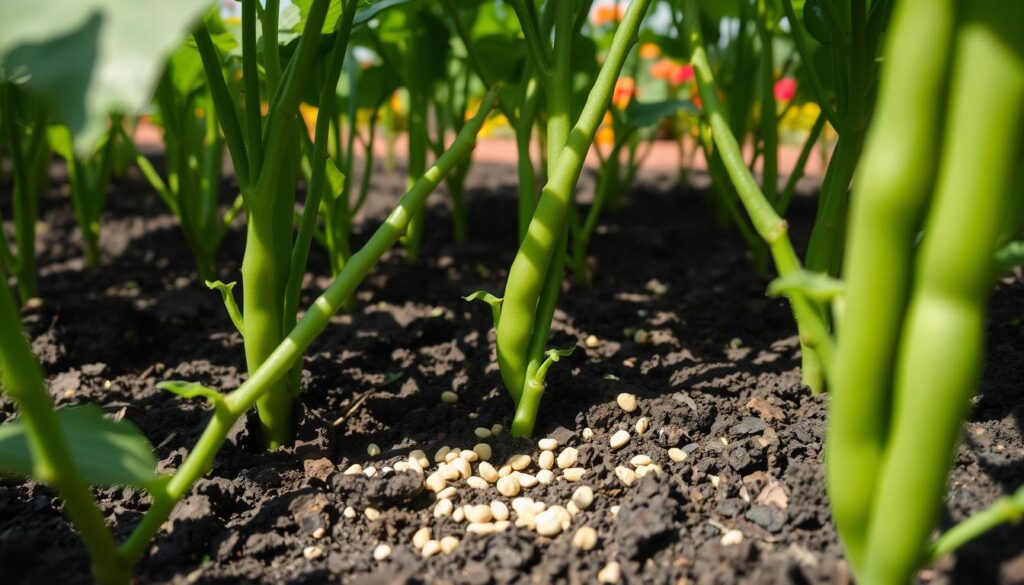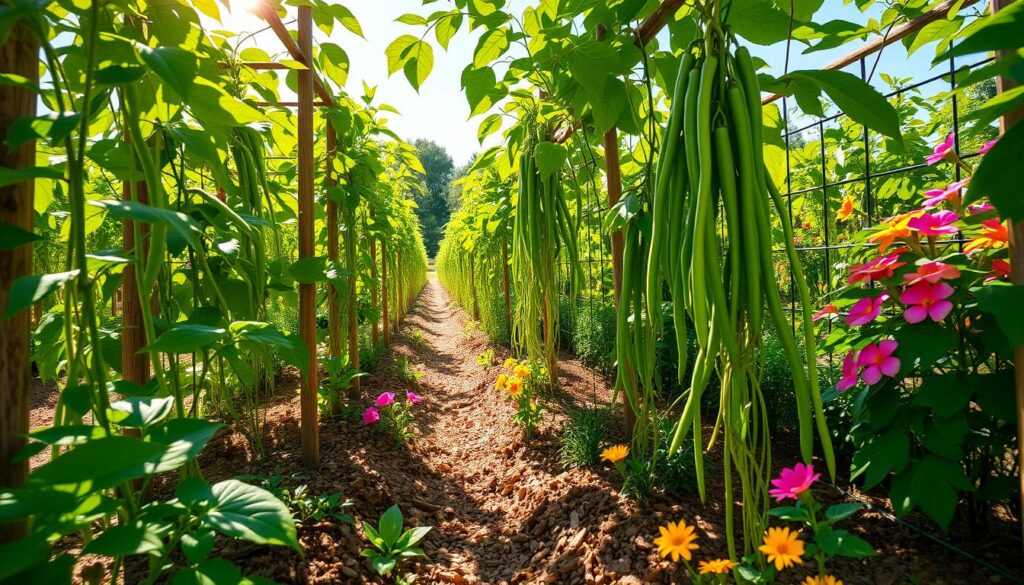Welcome to our guide on growing green beans. It’s a rewarding hobby that can bring you a lot of joy. With the right tips, you can have a big harvest. We’ll cover everything from the basics to advanced techniques.
Whether you’re new to gardening or have experience, this guide is for you. It will teach you how to grow tasty and healthy green beans. Our aim is to make growing green beans simple for everyone. By the end, you’ll be ready to grow green beans with confidence.
Key Takeaways
- Learn the basics of growing green beans and how to get started
- Discover the best green bean gardening tips for a successful harvest
- Understand the importance of proper soil preparation and care
- Learn how to identify and manage common pests and diseases
- Get tips on how to properly store and preserve your green bean harvest
- Find out how to grow green beans in containers or in a traditional garden bed
Understanding Different Types of Green Beans
When you start planting green beans, you’ll find many types to pick from. Each type has its own special traits. Knowing about the different green beans is key to caring for green bean plants and getting a good harvest. We’ll look at bush beans, pole beans, and runner beans. We’ll also share tips for your green bean growing guide.
Let’s explore the different green beans:
- Bush beans: compact, bushy plants that produce beans in a shorter period
- Pole beans: climbing plants that require support and produce beans over a longer period
- Runner beans: similar to pole beans, but with a more vigorous growth habit
Knowing the traits of each green bean type helps you pick the best for your garden. This way, you can make a detailed green bean growing guide for a successful harvest.
Bush Bean Varieties
Bush beans are a favorite for many gardeners. They’re easy to care for and give a lot of beans. They’re also good for beginners in planting green beans.
Pole Bean Varieties
Pole beans need more care but give more beans over time. They’re perfect for those who want beans all season.
Runner Bean Options
Runner beans are like pole beans but grow faster. They need more care but give lots of beans. They’re great for adding variety to your green bean growing guide.
| Type of Green Bean | Growth Habit | Yield |
|---|---|---|
| Bush Beans | Compact, bushy | High yield in a shorter period |
| Pole Beans | Climbing | Higher yield over a longer period |
| Runner Beans | Vigorous, climbing | High yield |
Perfect Growing Conditions for Green Beans
Green beans need the right growing conditions to grow well. Temperature, soil, and moisture are key. By following the best practices, you can make a great place for your plants.
Here are some tips for growing green beans:
- Choose a location with full sun and well-draining soil.
- Prepare the soil with a pH between 6.0 and 7.0.
- Provide support for your plants, such as a trellis or cage.
These tips will help you create the best environment for your green beans. Make sure to check and adjust the conditions to keep your plants healthy and productive.
Essential Tools and Materials Needed
To grow green beans, you need the right tools and materials. This includes basic gardening tools like seeds, soil, and watering cans. Choosing the right tools is key to a successful harvest, as shown in green bean gardening tips.
For example, a watering can with a long spout helps reach all parts of your garden. This ensures your green beans get enough water.
Support structures and trellises are also vital. They give your green beans the support they need as they grow. This is critical for pole bean varieties, which can grow very tall. By following green bean care instructions, your plants will thrive.
Basic Gardening Equipment
- Seeds
- Soil
- Watering cans
- Gardening gloves
Support Structures and Trellises
Support structures can be made from wood, metal, or plastic. Choose one that fits your garden size and green bean type.
Soil Amendments and Fertilizers
These improve your soil quality, giving your green beans the nutrients they need. By following green bean gardening tips and using the right soil amendments and fertilizers, you can have a healthy and abundant harvest.
How to Grow Green Beans Successfully
Growing green beans is fun and rewarding. To start, you need to know the basics. This includes picking the right variety, preparing the soil, and giving plants enough support.
Here are some key steps for growing green beans successfully:
- Plant seeds about 1-2 inches deep and 2-3 inches apart
- Water regularly, keeping the soil consistently moist
- Fertilize with a balanced fertilizer once a month
By following these steps and avoiding common mistakes, you can enjoy a bountiful harvest of delicious green beans. Make sure the soil drains well and support the plants as they grow. With the right care, you’ll have fresh, homegrown green beans all season.
For more info on growing green beans, talk to a local gardening expert or check online resources. With practice and patience, you’ll become a pro at growing green beans in no time.

| Variety | Maturity Days | Plant Height |
|---|---|---|
| Bush Bean | 50-60 | 12-18 inches |
| Pole Bean | 60-70 | 6-8 feet |
Soil Preparation and Planning
Soil preparation is key for a great green bean harvest. A good soil bed gives your beans the nutrients and air they need. Knowing how to prepare the soil is essential for a successful crop.
First, test your soil pH. Green beans do best in slightly acidic to neutral soil, between 6.0 and 7.0. You can buy a testing kit or send a sample to a lab. Adjust the pH with lime or sulfur based on the test results.
Soil pH Requirements
After testing, start preparing the soil. Add compost or manure to improve its structure and fertility. A green bean guide suggests adding a 2-inch compost layer for nutrients and better drainage.
Drainage Considerations
Good drainage is vital for green beans. They don’t like wet soil. Add organic matter or perlite to prevent waterlogging and root rot.
Spacing Guidelines
Plan your green bean spacing carefully. Plant bush beans 2-3 inches apart and pole beans 3-4 inches apart. A good guide will give you the best spacing for a high yield.
| Soil pH | Organic Matter | Drainage | Spacing |
|---|---|---|---|
| 6.0-7.0 | 2-inch layer of compost | Good drainage | 2-3 inches apart (bush), 3-4 inches apart (pole) |
Planting Techniques for Maximum Yield
When planting green beans, the right technique and planning are key for a big harvest. Start by sowing seeds 1-2 inches deep and 2-3 inches apart. As they grow, thin them out to 6 inches apart for better growth and air.
Caring for green bean plants means paying attention to watering, fertilizing, and pruning. Here are some tips:
- Water plants regularly but avoid too much water to prevent disease and root rot.
- Fertilize with a balanced fertilizer once a month to help them grow strong.
- Prune plants to keep them bushy and prevent them from getting too long.
By following these tips and creating the right conditions, you’ll get a lot of tasty green beans. Keep the soil moist and support the plants as they grow. With the right care, your green beans will flourish, and you’ll enjoy a fresh crop soon.

For more info on caring for green bean plants, talk to a local gardening expert or check online resources. With practice, you’ll become great at growing green beans.
| Planting Depth | Seed Spacing | Thinning |
|---|---|---|
| 1-2 inches | 2-3 inches | 6 inches |
Watering Requirements and Schedule
Proper watering is key for green bean care. It affects the plant’s growth and yield. Green bean tips stress the need for consistent moisture, mainly during germination and flowering.
To meet these needs, understanding your green beans’ watering schedule is vital.
A well-watered green bean plant yields more and tastes better. To manage moisture well, consider these tips:
- Water your green beans deeply once or twice a week, depending on weather.
- Avoid overwatering to prevent root rot and diseases.
- Use mulch to keep soil moist and reduce evaporation.
Common watering mistakes can harm your green bean plants. Some mistakes include:
Moisture Management Tips
By following these care instructions and tips, your plants will get the right water. This saves water and promotes healthy growth.
Remember, finding a balance between watering and drainage is key. This balance will reward you with a rich harvest of tasty green beans.
Fertilizing Your Green Bean Plants
To get a lot of green beans, you need to fertilize them right. A good green bean guide will tell you how important nutrients are. Look for a fertilizer with equal parts nitrogen, phosphorus, and potassium.
Here are some tips for fertilizing green beans:
- Soil testing to find out what nutrients are missing
- Using fertilizer when you plant and again when plants are 6 inches tall
- Don’t overdo it with fertilizer, as it can harm plants and cut down yields
By following these tips and picking the right fertilizer, your green beans will grow well. Always read the fertilizer instructions and avoid too much. With the right care, you’ll have a great green bean harvest.

For more tips on growing green beans, check out a trusted green bean guide. It will give you advice on fertilizing, pruning, and keeping pests away.
| Fertilizer Type | Nitrogen Content | Phosphorus Content | Potassium Content |
|---|---|---|---|
| Balanced Formula | 10% | 10% | 10% |
| High-Nitrogen Formula | 20% | 5% | 5% |
| Organic Formula | 5% | 5% | 5% |
Supporting and Training Growing Vines
Green beans need support to climb and grow well. The right support system is key for high yields and healthy plants. Green bean gardening tips highlight the importance of supporting and training vines.
Green beans are climbing plants that can grow very tall. They need a strong support system to avoid falling over. Green bean care instructions help you set up the right support.
Trellis Systems
A trellis system is great for supporting green beans. It gives them a structure to climb on, making them easy to manage. You can buy a trellis or make one from wood or metal.
Staking Methods
Staking is another way to support green beans. You place stakes next to each plant and tie the stems to them. This method works well for smaller gardens or shorter plants.
By following these green bean gardening tips and green bean care instructions, you can have a successful green bean garden. Make sure to provide the right support, and you’ll get a big harvest.
Managing Pests and Diseases
Managing pests and diseases is key for a good green bean harvest. A guide on growing green beans should cover common pests and diseases. By taking a few steps, you can keep your green beans healthy and thriving.
For more on container gardening, visit this website. It can help with your green bean cultivation.
Common Pests
Aphids, whiteflies, and spider mites are common pests of green beans. You can fight them with organic methods. Neem oil is a natural pesticide that works against many pests.
Disease Prevention
To prevent diseases like powdery mildew and root rot, ensure good air flow and water your plants right. Also, rotate your crops to keep the soil rich and prevent disease.
Organic Control Methods
Organic methods, like companion planting, can help prevent pests and diseases. For example, marigolds can keep nematodes away from your green beans.
Here are more tips for growing green beans:
- Use physical barriers to keep pests away
- Keep your garden clean to stop disease spread
- Watch your plants for signs of pests or disease

Container Growing Guidelines
Container growing is perfect for those with little space. Start by picking a container that’s 6-8 inches deep. Make sure it has holes for drainage. This helps your green beans grow well and prevents waterlogged soil.
Prepare the soil by adding compost or well-rotted manure. This boosts the soil’s quality and fertility. For the best results, use a balanced fertilizer and keep the soil moist.
Here are some extra tips for growing green beans in containers:
- Use a trellis or other support to help your green beans climb and grow upright
- Keep the container in a sunny location, such as a south-facing patio or balcony
- Water your green beans regularly, but avoid overwatering which can lead to disease and pests
By following these green bean gardening tips and using the right techniques, you can enjoy a bountiful harvest of delicious and healthy green beans, even in a small space. Whether you’re a seasoned gardener or just starting out, growing green beans in containers is a great way to get started.
With the right care and attention, your container-grown green beans will thrive and provide you with a continuous supply of fresh, tasty beans all season long. Happy growing green beans!
| Container Size | Soil Depth | Support |
|---|---|---|
| 6-8 inches | 6-8 inches | Trellis or other support |
Companion Planting Strategies
Companion planting makes your garden healthier and more balanced. It helps your green beans grow better, keeps pests away, and makes them taste better. It’s a key part of green bean care.
Best Plant Companions
Marigolds, radishes, and carrots are great with green beans. They keep pests away, attract good bugs, and make the soil better. For instance, marigolds fight nematodes that can hurt green beans. By using these tips, your garden will flourish.
Plants to Avoid
Don’t grow onions, garlic, or Brassica family plants with green beans. They take water and nutrients from green beans and attract pests.
Follow these care tips and use companion planting. Choose the right plants and avoid harmful ones. You’ll get a great harvest.
| Plant Companion | Benefits |
|---|---|
| Marigolds | Repels nematodes, attracts beneficial insects |
| Radishes | Repels cucumber beetles, improves soil health |
| Carrots | Improves soil health, reduces pests |
Harvesting and Storage Methods
As you near the end of your green bean gardening journey, it’s essential to know the best methods for harvesting and storing your beans. With the right green bean gardening tips, you can enjoy your fresh produce for a longer period. A good green bean growing guide will tell you when to harvest your beans.
When to Harvest
Green beans are ready when they’re 4-6 inches long and firm. Check by gently tugging on the bean. If it comes off easily, it’s ready to pick.
Proper Storage Techniques
To keep your green beans fresh, store them in a cool, dry place. You can also store them in the refrigerator for longer freshness. Here are some tips for storing green beans:
- Store green beans in a breathable container, such as a paper bag or a mesh bag.
- Keep green beans away from direct sunlight and heat sources.
- Do not wash green beans before storing them, as excess moisture can cause them to spoil.
Preserving Your Harvest
There are several ways to preserve your green bean harvest, including freezing, canning, and pickling. Freezing is simple and keeps nutritional value. You can also can green beans using a pressure canner or a water bath canner.
| Preservation Method | Description |
|---|---|
| Freezing | Blanch green beans in boiling water, then freeze them in airtight containers or freezer bags. |
| Canning | Use a pressure canner or a water bath canner to can green beans in a brine solution. |
| Pickling | Soak green beans in a brine solution with vinegar and spices to create a tangy and crunchy snack. |
Saving Seeds for Next Season
When growing green beans, saving seeds for next season is a smart move. It helps you keep your favorite varieties and saves money on seeds. To save seeds, let some green bean plants mature fully. Wait until the pods are dry and brittle.
Here are some steps to follow for saving seeds:
- Let the pods dry completely on the plant
- Remove the seeds from the pods
- Store the seeds in a cool, dry place
By following these steps, you can save seeds from your
Don’t forget to label your saved seeds. Write the variety name and date on them. This way, you can easily find them when it’s time to plant again. With a bit of planning and care, you can enjoy a continuous harvest of delicious growing green beans from your own saved seeds.
Conclusion: Growing Green Bean Success
Growing green beans can be very rewarding. You just need the right knowledge and techniques. You’ve learned about different bean varieties and how to prepare the soil, water, and manage pests.
Now, you know how to grow a lot of green beans. Use the best practices like providing support, fertilizing, and planting with companions. This will help you get the most out of your garden.
Don’t forget to watch your plants closely and fix any problems quickly. This keeps them healthy and growing well.
We want to hear about your green bean growing adventures. Share your experiences, ask questions, and give feedback. Your input will help us make this guide even better for gardeners.
Enjoy growing your own green beans. It’s a fun and rewarding experience. Happy gardening!
FAQ
What are the different types of green beans?
There are three main types of green beans. Bush beans grow in compact plants. Pole beans and runner beans grow on vines that need support. Each type has its own unique characteristics, such as yield, disease resistance, and growing habits.
What are the ideal growing conditions for green beans?
Green beans prefer well-drained, nutrient-rich soil with a pH between 6.0 and 7.0. They thrive in full sun and warm temperatures, typically between 65°F and 85°F. Consistent moisture is important, but avoid letting the soil become waterlogged.
What tools and materials do I need to grow green beans?
To grow green beans, you’ll need seeds, gardening tools (like a trowel and pruners), support structures (like trellises or cages), and soil amendments (such as compost or fertilizer). Choosing the right tools and materials is key to a successful green bean crop.
How do I plant and care for green bean plants?
To plant green beans, sow the seeds about 1-2 inches deep and 4-6 inches apart in rows or hills. Water the soil regularly, and provide support for the plants as they grow. Fertilize your plants using a balanced, slow-release fertilizer, and be sure to water and prune them as needed.
How do I manage pests and diseases on my green bean plants?
Common pests that can affect green beans include aphids, spider mites, and bean beetles. Diseases like bacterial blight, rust, and powdery mildew can also be problematic. Use organic pest control methods, practice crop rotation, and maintain good garden hygiene. Identifying and addressing problems early is key to keeping your green bean plants healthy.
When should I harvest my green beans?
Green beans are ready to harvest when the pods are firm, crisp, and about 4-6 inches long. Regularly check your plants and pick the beans at the right time for the best flavor and texture. After harvesting, store the beans in the refrigerator for up to a week or freeze them for longer-term storage.
How can I save green bean seeds for next season?
Saving green bean seeds is a great way to preserve your favorite varieties and save money. Allow some of your beans to fully mature on the plant, then collect the dried seeds. Store them in a cool, dry place. Be sure to label the seeds with the variety and year.
Share this post: on Twitter on Facebook

